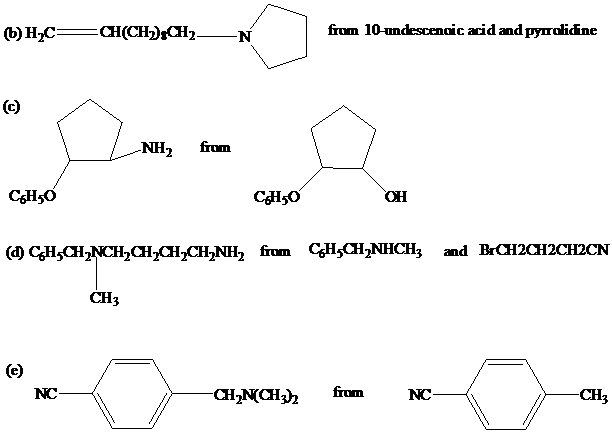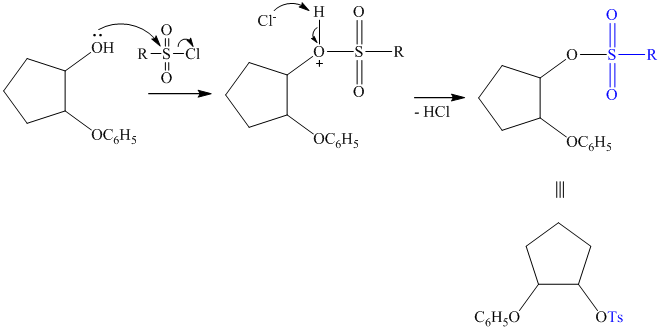
Concept explainers
Devise efficient syntheses of each of the following compounds from the designated startingmaterials. You may also use any necessary organic or inorganic reagents.

Interpretation:
Efficient syntheses are to be designed for each of the five compounds with designated starting materials and necessary organic or inorganic compounds.
Concept introduction:
Synthesis of amines can be done in a variety of ways, based on forming a bond between a carbon and a nitrogen.
Nucleophilic substitution reactions on alkyl halides or alcohols by a nitrogen containing reagent is one of the common methods.
Primary amines can be synthesized by nucleophilic substitution of an alkyl halide with cyanide. The resulting compound, called a nitrile, yields a primary amine on catalytic reduction with hydrogen.
Secondary and particularly tertiary amines can be formed by reaction between ammonia and an excess of alkyl halide.
Another method involves nucleophilic addition of simpler amines to an aldehyde or a ketone.
Carboxylic acid derivatives such as acid halides, anhydrides, and esters undergo nucleophilic substitution by ammonia or a variety of simpler amines to give amides. The amides on reduction gives amines.
Benzyl radical is stabilized by delocalization of the unpaired electron on to the benzene ring. This helps in selective radical substitution of hydrogens and halogens in benzylic position.
Answer to Problem 45P
Solution:

 from
from

c)
 from
from  :
:

d)

e)
 from
from  :
:

Explanation of Solution
a)
The substrate is a primary alkyl halide; therefore, substitution of the bromine requires a strong nucleophile such as cyanide ion via an

The nitrile yields the desired amine on catalytic reduction.

b)
 from
from
Carboxylic acids and amines can react to form amides by nucleophilic substitution of the hydroxyl group by the amine. However, carboxylic acids are poor electrophiles and are relatively unreactive. The first step is then to activate the acid by converting it to a stronger electrophile such as an acid chloride.

The chloride then undergoes substitution by

This contains both a carbonyl group that needs to be reduced to a methylene and a double bond. Catalytic reduction will result in reduction of the carbonyl group as well as an unwanted reduction of the double bond. Therefore, reduction of the carbonyl to methylene bridge is done with lithium aluminum hydride.

The hydride ion (
c)
 from
from  :
:
The synthesis requires substitution of the hydroxyl group of the substrate. Hydroxyl group is a poor leaving group as the hydroxide ion is a strong base. It first needs to be converted to a better leaving group. This is done by reaction with tosyl chloride, to give a tosylate.

Tosylate ion is the conjugate base of a strong acid, so it can be easily replaced by a suitable nucleophile like phthalimide.

Reaction of the tosylate with phthalimide is an

d)
The first of the designated starting compounds

The nitrile (cyanide) function can then be reduced with hydrogen over palladium to yield the desired product.

e)
The methyl substituent on the benzene ring needs to be converted to an amine. This requires first converting it to an alkyl halide. This is a substitution of a hydrogen in a benzylic position. A convenient method is to treat it with

The resulting bromide can be reacted directly with dimethyl amine to yield the product. However, there is a possibility of formation of a quaternary ammonium compound. Therefore, the bromide is converted to a primary alcohol by reacting it with hydroxide.

The alcohol is then oxidized to aldehyde using pyridiniumchlorochromate.

Reaction of the aldehyde can then be subjected to reductive amination, reaction with dimethyl amine in the presence of sodium borohydride, to yield the desired product. The reaction initially forms an imine, but that is directly reduced by sodium borohydrideinstead of isolating it.

Want to see more full solutions like this?
Chapter 22 Solutions
Organic Chemistry - Standalone book
- . 3°C with TH 12. (10pts total) Provide the major product for each reaction depicted below. If no reaction occurs write NR. Assume heat dissipation is carefully controlled in the fluorine reaction. 3H 24 total (30) 24 21 2h • 6H total ● 8H total 34 래 Br2 hv major product will be most Substituted 12 hv Br NR I too weak of a participate in P-1 F₂ hv Statistically most favored product will be major = most subst = thermo favored hydrogen atom abstractor to LL Farrow_forwardFive chemistry project topic that does not involve practicalarrow_forwardPlease correct answer and don't used hand raitingarrow_forward
- Q2. Consider the hydrogenation of ethylene C2H4 + H2 = C2H6 The heats of combustion and molar entropies for the three gases at 298 K are given by: C2H4 C2H6 H2 AH comb/kJ mol¹ -1395 -1550 -243 Sº / J K¹ mol-1 220.7 230.4 131.1 The average heat capacity change, ACP, for the reaction over the temperature range 298-1000 K is 10.9 J K¹ mol¹. Using these data, determine: (a) the standard enthalpy change at 800 K (b) the standard entropy change at 800 K (c) the equilibrium constant at 800 K.arrow_forward13. (11pts total) Consider the arrows pointing at three different carbon-carbon bonds in the molecule depicted below. Bond B Bond A Bond C a. (2pts) Which bond between A-C is weakest? Which is strongest? Place answers in appropriate boxes. Weakest Bond Strongest Bond b. (4pts) Consider the relative stability of all cleavage products that form when bonds A, B, AND C are homolytically cleaved/broken. Hint: cleavage products of bonds A, B, and C are all carbon radicals. i. Which ONE cleavage product is the most stable? A condensed or bond line representation is fine. ii. Which ONE cleavage product is the least stable? A condensed or bond line representation is fine. c. (5pts) Use principles discussed in lecture, supported by relevant structures, to succinctly explain the why your part b (i) radical is more stable than your part b(ii) radical. Written explanation can be no more than one-two succinct sentence(s)! Googlearrow_forwardPrint Last Name, First Name Initial Statifically more chances to abstract one of these 6H 11. (10pts total) Consider the radical chlorination of 1,3-diethylcyclohexane depicted below. 4 4th total • 6H total 래 • 4H total 21 total ZH 2H Statistical H < 3° C-H weakest - product abstraction here bund leads to thermo favored a) (6pts) How many unique mono-chlorinated products can be formed and what are the structures for the thermodynamically and statistically favored products? Product 6 Number of Unique Mono-Chlorinated Products Thermodynamically Favored Product Statistically Favored Product b) (4pts) Draw the arrow pushing mechanism for the FIRST propagation step (p-1) for the formation of the thermodynamically favored product. Only draw the p-1 step. You do not need to include lone pairs of electrons. No enthalpy calculation necessary H H-Cl Waterfoxarrow_forward
- 10. (5pts) Provide the complete arrow pushing mechanism for the chemical transformation → depicted below Use proper curved arrow notation that explicitly illustrates all bonds being broken, and all bonds formed in the transformation. Also, be sure to include all lone pairs and formal charges on all atoms involved in the flow of electrons. CH3O II HA H CH3O-H H ①arrow_forwardDo the Lone Pairs get added bc its valence e's are a total of 6 for oxygen and that completes it or due to other reasons. How do we know the particular indication of such.arrow_forwardNGLISH b) Identify the bonds present in the molecule drawn (s) above. (break) State the function of the following equipments found in laboratory. Omka) a) Gas mask b) Fire extinguisher c) Safety glasses 4. 60cm³ of oxygen gas diffused through a porous hole in 50 seconds. How long w 80cm³ of sulphur(IV) oxide to diffuse through the same hole under the same conditions (S-32.0.0-16.0) (3 m 5. In an experiment, a piece of magnesium ribbon was cleaned with steel w clean magnesium ribbon was placed in a crucible and completely burnt in oxy cooling the product weighed 4.0g a) Explain why it is necessary to clean magnesium ribbon. Masterclass Holiday assignmen PB 2arrow_forward
- Hi!! Please provide a solution that is handwritten. Ensure all figures, reaction mechanisms (with arrows and lone pairs please!!), and structures are clearly drawn to illustrate the synthesis of the product as per the standards of a third year organic chemistry course. ****the solution must include all steps, mechanisms, and intermediate structures as required. Please hand-draw the mechanisms and structures to support your explanation. Don’t give me AI-generated diagrams or text-based explanations, no wordy explanations on how to draw the structures I need help with the exact mechanism hand drawn by you!!! I am reposting this—ensure all parts of the question are straightforward and clear or please let another expert handle it thanks!!arrow_forwardIn three dimensions, explain the concept of the velocity distribution function of particles within the kinetic theory of gases.arrow_forwardIn the kinetic theory of gases, explain the concept of the velocity distribution function of particles in space.arrow_forward
 Organic ChemistryChemistryISBN:9781305580350Author:William H. Brown, Brent L. Iverson, Eric Anslyn, Christopher S. FootePublisher:Cengage Learning
Organic ChemistryChemistryISBN:9781305580350Author:William H. Brown, Brent L. Iverson, Eric Anslyn, Christopher S. FootePublisher:Cengage Learning

